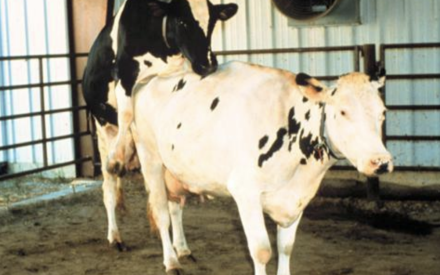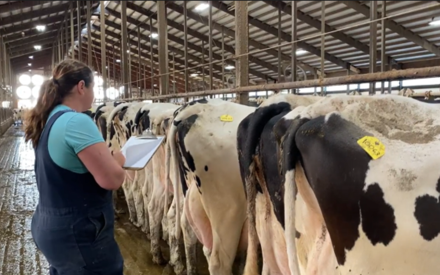English | Spanish
Table of Contents

Introduction
For nearly eighty years dairy producers have been indoctrinated in the use of the AM-PM rule for artificial insemination (AI) of cattle. The AM-PM rule dictates that a cow should receive AI 12 hours after first being observed in estrus. If a cow is seen in estrus in the AM she should receive AI that PM, and cows seen in estrus in the PM should receive AI the following AM. The AM-PM rule requires twice daily AI. However, twice daily AI puts added stress on farm labor, requires additional animal handling, and creates scheduling issues for AI technicians. So, do we still need the AM-PM rule (twice daily AI) or can once daily AI result in acceptable fertility?
How did the AM-PM rule come about?
Research in the 1940s by George Trimberger at Nebraska demonstrated that conception rates were greatest when cows were inseminated between the middle and the end of estrus but were still acceptable between 6 to 12 hours after estrus. Cows bred immediately at the beginning of estrus had slightly lower conception rates, and so the recommendation to delay AI came about. At that point in history, AI in cattle was still in it’s infancy, and these findings gave producers the first recommendations on AI timing.
Strictly adhering to the AM-PM rule requires twice daily AI. Since that time, though, studies have indicated that once-daily AI can result in the same fertility as twice-daily AI.
| # of Cows | 75 d Non-return Rate (%) | |
| AM/PM Rule | 3659 | 60.1 |
| Once Daily AI | 3581 | 60.6 |
Why the discrepancy?
There are a couple of possible reasons. First, the experiments by Trimberger did not study the number of cows that is expected by today’s research standards to draw meaningful conclusions. That said, observations using the electronic estrus detection HeatWatch System at Virginia Tech verify much of the early findings. In their experiment, conception rates were greatest from 4 to 12 hours after the onset of estrus. Cows bred from 0 to 4 hours after the onset of estrus did have lower conception rates.
| Hours onset estrus to AI | # of Breedings | Conception Rate (%) |
| 0-4 | 327 | 43.1 |
| 4-8 | 735 | 50.9 |
| 8-12 | 677 | 51.1 |
| 12-16 | 459 | 46.2 |
| 16-20 | 317 | 28.1 |
| 20-24 | 139 | 31.7 |
| 24-26 | 7 | 14.3 |
An additional reason for evolving recommendations is that our modern high-producing dairy cow exhibits estrous behavior for a shorter period of time than her ancestors. Work at UW-Madison shows that duration of estrus declines with increasing milk production.
Today’s high-producing dairy cow is more difficult to observe in estrus. If we knew exactly when she first exhibited estrus, there would be some benefit to the AM-PM rule and twice-daily AI. But the reality on most farms is that we don’t know when a cow first exhibited estrus. There is more risk in breeding a cow too late than too early with the AM-PM rule, which is why once-daily AI has proven to be equally successful. Scheduling labor and AI technicians for once vs twice daily AI is another important factor to consider.
Flash forward a decade since this article was first published, and the debate over the AM-PM rule continues
One reason is the rapid adoption of sexed semen technology. This technology is still evolving, and the interaction between sexed semen and AI timing continues to be of interest. Sexed semen goes through additional processing compared to conventional semen. The number of sperm per unit of sexed semen varies by product, but often contains fewer sperm than one unit of conventional semen. Because of these factors sexed semen requires more attention to detail, including AI timing. Farms using sexed semen and AI to detect estrus may benefit from an increased frequency in the number of times per day animals are observed for estrus.
Some research studies have indicated that delaying AI when using sexed semen based upon estrus detection (no synchronization) may result in improved conception rates, but more data is needed before drawing definitive conclusions. UW-Madison studies have consistently shown no benefit of delaying the timing of AI for sexed semen paired with AI to synchronization program. Instead, they have shown that it’s more critical to time AI at the right interval relative to ovulation, rather than try to alter the timing of AI. Re-incorporating twice daily AI may assist farms in achieving this goal.
Activity monitoring technology has also rapidly evolved, making these systems more applicable to commercial dairy settings. In these systems, optimal timing of AI is often farm-specific, and impacted by the activity thresholds set in the system before an alert is provided to the herd manager. The AM-PM rule may be of benefit to some herds using these systems.
Take-home messages
Once daily AI to estrus detection using conventional semen has similar fertility to twice daily AI (AM PM rule)
Sexed semen is less forgiving on AI timing errors than conventional semen. Increased frequency of estrus detection and/or returning to twice-daily AI can be beneficial to fertility.
Twice daily AI may be beneficial to farms using electronic activity monitoring systems, depending on the activity thresholds set and the frequency managers generate reports to identify cows for AI.
This article was originally published 2010 and updated in Winter 2023.
References
Bombardelli, Gabriel D., Henrique F. Soares, and Ricardo C. Chebel. “Time of insemination relative to reaching activity threshold is associated with pregnancy risk when using sex-sorted semen for lactating Jersey cows.” Theriogenology 85.3 (2016): 533-539.
Dransfield, M. B. G., et al. “Timing of insemination for dairy cows identified in estrus by a radiotelemetric estrus detection system.” Journal of dairy science 81.7 (1998): 1874-1882.
Lauber, M. R., et al. “Comparison of reproductive management programs for submission of Holstein heifers for first insemination with conventional or sexed semen based on expression of estrus, pregnancy outcomes, and cost per pregnancy.” Journal of Dairy Science 104.12 (2021): 12953-12967.
LeRoy, C. N. S., J. S. Walton, and S. J. LeBlanc. “Estrous detection intensity and accuracy and optimal timing of insemination with automated activity monitors for dairy cows.” Journal of dairy science 101.2 (2018): 1638-1647.
Lopez, H., L. D. Satter, and M. C. Wiltbank. “Relationship between level of milk production and estrous behavior of lactating dairy cows.” Animal reproduction science 81.3-4 (2004): 209-223.
Nebel, R. “Time of insemination relative to onset of activity threshold of cow manager is associated with pregnancy risk when using gender selected semen for Jersey cattle.” Dairy and Vet. Sci. J. 5 (2018): 1-3.
Nebel, R. L., et al. “Timing of artificial insemination of dairy cows: fixed time once daily versus morning and afternoon.” Journal of dairy science 77.10 (1994): 3185-3191.
Author

Ryan Sterry
Regional Dairy Educator / Professor – Ryan Sterry is a Regional Dairy Educator and Professor with the University of Wisconsin – Madison, Division of Extension. With a home office in St. Croix County, Ryan serves Barron, Pierce, and St. Croix Counties. His educational programming and research focuses on dairy management, cattle reproduction, and Beef x Dairy crossbreds.


 Proper semen handling for improved fertility in bovines and other livestock
Proper semen handling for improved fertility in bovines and other livestock Effects of Heat Stress on Dairy Reproduction
Effects of Heat Stress on Dairy Reproduction Estrus detection & Estrus detection aids
Estrus detection & Estrus detection aids Synchronization protocols and compliance for dairy cattle reproduction
Synchronization protocols and compliance for dairy cattle reproduction


